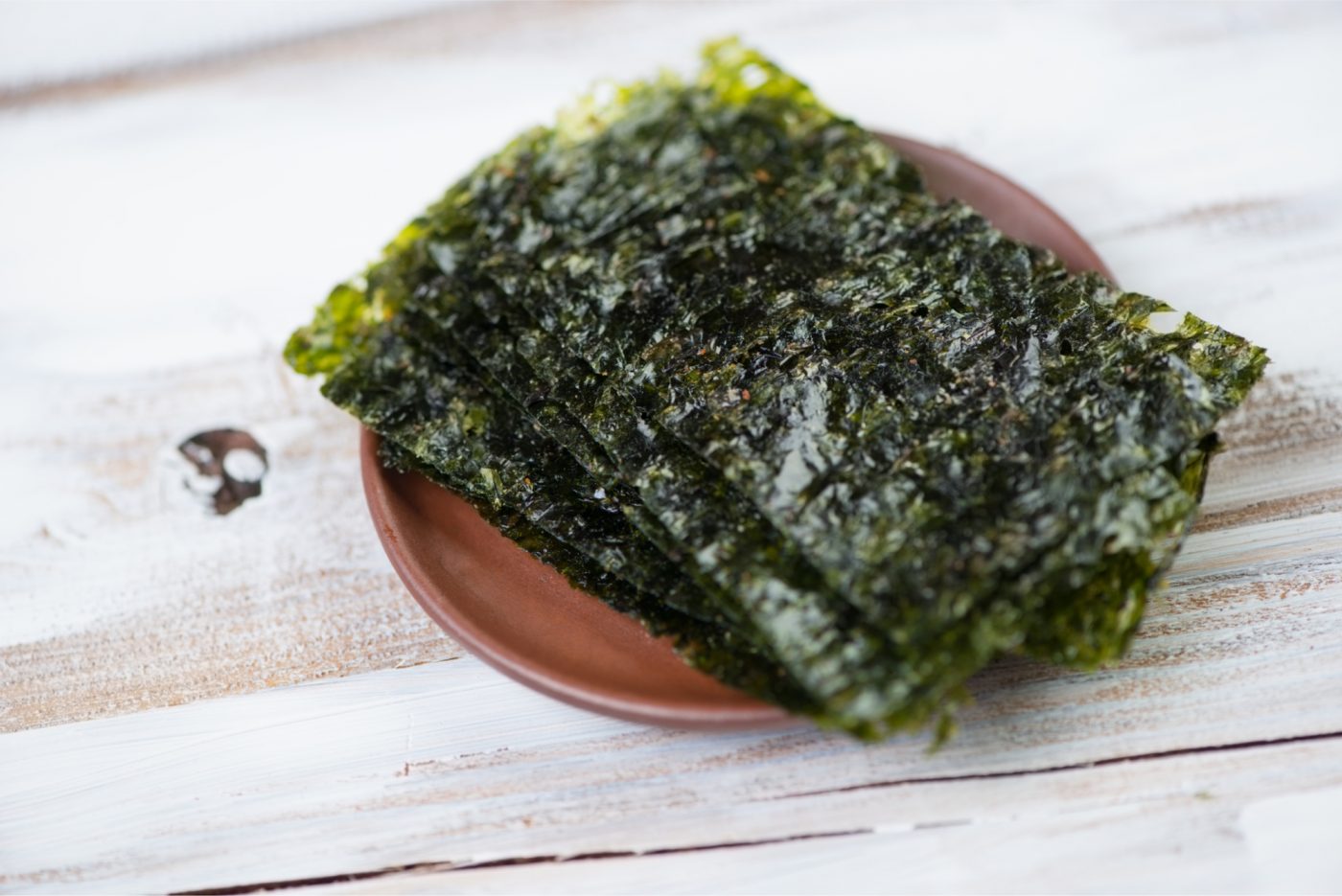Iodine is a trace element that is a fundamental component of the thyroid hormones thyroxine and triiodothyronine, which control the formation of proteins in the human body and are thus essential for tissue growth and cell division.1 2 Iodine deficiency is a significant health problem worldwide. Iodine is present in the ocean and soil, in varying degrees, but occurs mostly in marine animal protein and sea vegetables. For those on a plant-based diet, healthy sources of iodine include algae and iodised table salt.3
According to the World Health Organization, around a third of the global population – and as much as half of Europe’s population – is affected by an insufficient iodine supply.
Function of iodine in the body
As well as controlling the formation of proteins,4 thyroid hormones also influence the development of bones and the brain, the metabolism of carbohydrates, proteins, and fats, and the basal metabolic rate (the energy consumption of the human body when at complete rest for the maintenance of bodily functions). If the thyroid gland is overactive, the basal metabolic rate is increased; if it is underactive, it is reduced.5
Occurrence of iodine
The iodine content of food (see Table 1) is characterized by strong regional fluctuations and depends on the natural iodine content of the soil and water, as well as production conditions (including plant fertilization and the iodine content of animal feed).
In many countries, iodised table salt is now an important source of iodine.6 7 Foods that have a naturally high iodine content are almost exclusively seafood and seaweed/algae. The most important plant-based sources of iodine in terms of quantity – taking iodised table salt into account – are fortified bread and seaweeds.
Food | iodine (mcg/100g) |
Table salt, iodised | 5070 |
Nori algae | 2320 |
Fish sticks or patty cooked | 68.7 |
Salmon filet cooked | 16.5 |
Crustaceans (e.g. shrimp), precooked | 15.4 |
Granola, cereals | 10.8 |
Veggie soy burger | 9.7 |
Raw Spinach | 6.0 |
Fortified soy milk | 2.9 |
Multigrain bread | 1.8 |
Pinto beans | 1.2 |
Mushrooms | 0.3 |
Peanuts | 0.7 |
Iodine requirement
A daily intake of 150 micrograms of iodine is recommended for adults,9 the bulk of which can be provided through 5 grams of iodised table salt, which provides 75-125 micrograms of iodine.10 The body’s iodine supply can be measured by the excretion of iodine in the urine: the more iodine is excreted, the higher the iodine supply.
Iodine deficiency
Insufficient iodine intake leads to a reduced blood concentration of thyroid hormones. To compensate for the deficit, the thyroid gland grows in size (resulting in a goiter, a swelling of the thyroid gland located at the base of the neck) so that more thyroid hormones can be produced. In the long term, this can lead to hypothyroidism, which results in reduced hormone production: physical and mental performance is significantly impaired, including increased susceptibility to infections.11
Iodine during pregnancy
Chronic iodine deficiency during pregnancy increases the likelihood of stillbirths and miscarriages. Iodine deficiency in a child before birth, during breastfeeding, or in infancy leads to growth disorders and irreparable developmental disorders of the brain, and other organs.12 Unlike in some poorer countries, these severe forms of iodine deficiency rarely occur in industrialized countries. However, in the long term, an insufficient supply of iodine can lead to impaired mental and motor performance.13
Iodine deficiency: a society-wide problem
Insufficient dietary iodine intake is not just a problem specific to vegetarians and vegans, but affects the entire population. Although iodine supply has improved significantly in recent years, mainly through the use of iodised table salt, around 30% of the world population has a mild to moderate iodine deficiency, or is at risk of developing a deficiency.14 Moreover, the facts show that the use of iodised salt – contrary to what critics of iodine-fortification claim – neither triggers nor aggravates thyroid diseases, nor does it lead to secondary diseases.
Iodine supply in vegetarian diets
In the few studies available, iodine intake below the recommended levels were often found in vegetarians and especially in vegans. The average excretion of iodine in the urine is lower in people on a vegetarian diet than in people on a mixed diet, but significantly higher than in people on a vegan diet.15
Since milk and dairy products also contribute to iodine supply, it can be assumed that people following a vegetarian diet are at no greater risk of iodine deficiency than people who eat meat. However, since the average iodine intake of both groups is not optimal, both vegetarians and meat eaters should improve their iodine intake by using iodised table salt.16
Keep an eye on iodine when following a plant-based diet
People on a vegan diet, on the other hand, are considered an at-risk group for insufficient iodine supply. It is therefore recommended that people on a plant-based diet ensure an adequate iodine intake by using only iodised table salt and eating seaweed with a moderate iodine content (such as nori). However, there is a risk of adverse health effects when consuming very iodine-rich types of seaweed. With this in mind, consumption is not recommended if iodine content exceeds 20 mg/kg of the dry product.17 18
Certain foods inhibit iodine absorption
Many foods, including cruciferous vegetables, sweet potatoes, and soy beans are goitrogens, which means that they contain ingredients that promote goiter formation in excess, as they bind iodine from food and thus reduce its bioavailability19 (bioavailability refers to the extent to which the body can absorb and utilize the iodine present in food). As such, it is important to eat a varied diet and thus reduce the effects of goitrogens. This can be particularly important if iodine intake is very low. For those following a completely plant-based diet, it might be useful to take iodine supplements. However, iodine status should first be determined by a doctor.
Conclusion
- In iodine-deficient regions, most people are likely to be affected to some degree by iodine deficiency, regardless of their diet.
- The consumption of iodised salt leads to a significant improvement in general iodine intake.
- While vegetarians do not have an increased risk of iodine deficiency compared to people following a mixed diet, both dietary groups tend to consume lower amounts of iodine than required by the body.
- People following a vegan diet are considered to be at risk of iodine deficiency and should pay particular attention to adequate iodine intake.
References
- Rigutto-Farebrother, J. (2023). Optimizing Growth: The Case for Iodine. Nutrients, 15(4). https://doi.org/10.3390/nu15040814
- Rigutto-Farebrother, J. (2023). Optimizing Growth: The Case for Iodine. Nutrients, 15(4). https://doi.org/10.3390/nu15040814
- Rigutto-Farebrother, J. (2023). Optimizing Growth: The Case for Iodine. Nutrients, 15(4). https://doi.org/10.3390/nu15040814
- Rigutto-Farebrother, J. (2023). Optimizing Growth: The Case for Iodine. Nutrients, 15(4). https://doi.org/10.3390/nu15040814
- Teixeira PFDS, Dos Santos PB, Pazos-Moura CC. The role of thyroid hormone in metabolism and metabolic syndrome. Ther Adv Endocrinol Metab. 2020 May 13;11:2042018820917869. doi: 10.1177/2042018820917869. PMID: 32489580; PMCID: PMC7238803.
- Gärtner R. Recent data on iodine intake in Germany and Europe. J Trace Elem Med Biol. 2016 Sep;37:85-89. doi: 10.1016/j.jtemb.2016.06.012. Epub 2016 Jul 1. PMID: 27421794.
- BIBAN, B., & LICHIARDOPOL, C. (2017). Iodine Deficiency, Still a Global Problem? Current Health Sciences Journal, 43(2), 103-111. https://doi.org/10.12865/CHSJ.43.02.01
- USDA, FDA and ODS-NIH Database for the Iodine Content of Common Foods. Available at: https://www.ars.usda.gov/ARSUSERFILES/80400535/DATA/IODINE/IODINE%20DATABASE_DOCUMENTATION.PDF
- Scientific Committee on Food (2002). Opinion of the Scientific Committee on Food on the tolerable upper intake level of iodine.
- Iacone R, Iaccarino Idelson P, Russo O, Donfrancesco C, Krogh V, Sieri S, Macchia PE, Formisano P, Lo Noce C, Palmieri L, Galeone D, Rendina D, Galletti F, Di Lenarda A, Giampaoli S, Strazzullo P, On Behalf Of The Minisal-Gircsi Study Group. Iodine Intake from Food and Iodized Salt as Related to Dietary Salt Consumption in the Italian Adult General Population. Nutrients. 2021 Sep 30;13(10):3486. doi: 10.3390/nu13103486. PMID: 34684487; PMCID: PMC8537510.
- Iodine, Fact Sheet for Health Professionals. NIH, 2023. Available at: https://ods.od.nih.gov/factsheets/Iodine-HealthProfessional/#h11
- Nie, J., Zhu, Y., Wang, C., Lin, Q., Tayier, R., Cai, Z., Ma, P., & Zhang, L. (2023). Relationship between iodine knowledge and dietary iodine intake in pregnant and lactating women: A cross-sectional study. Public Health Nutrition, 26(7), 1436-1450. https://doi.org/10.1017/S1368980023000514
- Hatch-McChesney, A., & Lieberman, H. R. (2022). Iodine and Iodine Deficiency: A Comprehensive Review of a Re-Emerging Issue. Nutrients, 14(17). https://doi.org/10.3390/nu14173474
- Hatch-McChesney, A., & Lieberman, H. R. (2022). Iodine and Iodine Deficiency: A Comprehensive Review of a Re-Emerging Issue. Nutrients, 14(17). https://doi.org/10.3390/nu14173474
- Eveleigh ER, Coneyworth LJ, Avery A, Welham SJM. Vegans, Vegetarians, and Omnivores: How Does Dietary Choice Influence Iodine Intake? A Systematic Review. Nutrients. 2020 May 29;12(6):1606. doi: 10.3390/nu12061606. PMID: 32486114; PMCID: PMC7352501.
- Eveleigh, E. R., Coneyworth, L. J., Avery, A., & M. Welham, S. J. (2020). Vegans, Vegetarians, and Omnivores: How Does Dietary Choice Influence Iodine Intake? A Systematic Review. Nutrients, 12(6). https://doi.org/10.3390/nu12061606
- Nicol, K., Nugent, A. P., Woodside, J. V., Hart, K. H., & Bath, S. C. (2023). Iodine and plant-based diets: A narrative review and calculation of iodine content. The British Journal of Nutrition, 131(2), 265-275. https://doi.org/10.1017/S0007114523001873
- Iodine intake in Germany on the decline again – tips for a good iodine intake. BfR 2021. Available at: https://www.bfr.bund.de/cm/349/iodine-intake-in-germany-on-the-decline-again-tips-for-a-good-iodine-intake.pdf
- Purohit, P., Rawat, H., Verma, N., Mishra, S., Nautiyal, A., Bhatt, S., Bisht, N., Aggarwal, K., Bora, A., Kumar, H., Rawal, P., Kumar, A., Kapoor, R., Sehrawat, J., Rather, M. A., Naik, B., Kumar, V., Rustagi, S., Preet, M. S., . . . Gupta, A. K. (2023). Analytical approach to assess anti-nutritional factors of grains and oilseeds: A comprehensive review. Journal of Agriculture and Food Research, 14, 100877. https://doi.org/10.1016/j.jafr.2023.100877



